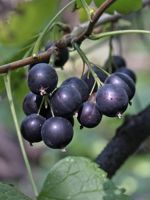Mon-Fri 9am - 5pm Mountain time
Northern Black Currant vs Bilberry
Ribes hudsonianum
Vaccinium myrtillus
CUSTOM GROW
CUSTOM GROW
Northern Black Currant is a native deciduous shrub found across Canada and the northern United States. Dark purple to black berries that ripen in summer and provide food for wildlife and humans. Fragrant yellow-green flowers that attract a wide variety of pollinators.
This shrub is well adapted to moist soils and can even survive periods of flooding. It has an interesting bronze colour in fall.
Bilberry is a native perennial shrub valued for its small, blue-black berries that ripen in mid to late summer. The berries resemble blueberries but have a richer, more tart, and intense flavor. They have long been used for fresh eating, baking, and preserves, while also providing food for birds and mammals. In spring, its delicate pinkish flowers attract bees and other pollinators.
Growing low to the ground, Bilberry forms spreading colonies that create dense understory cover. This growth habit provides food and shelter for wildlife, and its foliage adds seasonal interest by turning red to purple in autumn. With its adaptability and ecological benefits, Bilberry is well-suited for naturalization, ecological restoration, and pollinator gardens.
Northern Black Currant Quick Facts
Bilberry Quick Facts
Toxicity: leaves may be unsafe in high doses

